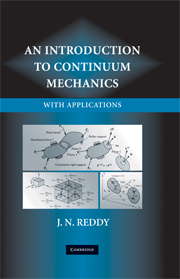Book contents
- Frontmatter
- Contents
- Preface
- 1 Introduction
- 2 Vectors and Tensors
- 3 Kinematics of Continua
- 4 Stress Measures
- 5 Conservation of Mass, Momenta, and Energy
- 6 Constitutive Equations
- 7 Linearized Elasticity Problems
- 8 Fluid Mechanics and Heat Transfer Problems
- 9 Linear Viscoelasticity
- References
- Answers to Selected Problems
- Index
7 - Linearized Elasticity Problems
- Frontmatter
- Contents
- Preface
- 1 Introduction
- 2 Vectors and Tensors
- 3 Kinematics of Continua
- 4 Stress Measures
- 5 Conservation of Mass, Momenta, and Energy
- 6 Constitutive Equations
- 7 Linearized Elasticity Problems
- 8 Fluid Mechanics and Heat Transfer Problems
- 9 Linear Viscoelasticity
- References
- Answers to Selected Problems
- Index
Summary
You cannot depend on your eyes when your imagination is out of focus.
Mark TwainResearch is to see what everybody else has seen, and to think what nobody else has thought.
Albert Szent-GyoergiIntroduction
This chapter is dedicated to the study of deformation and stress in solid bodies under a prescribed set of forces and kinematic constraints. We assume that stresses and strains are small so that linear strain–displacement relations and Hooke's law are valid, and we use appropriate governing equations, called field equations, derived in the previous chapters. Mathematically, we seek solutions to coupled partial differential equations over an elastic domain occupied by the reference (or undeformed) configuration of the body, subject to specified boundary conditions on displacements and forces. Such problems are called boundary value problems of elasticity.
Most practical problems of even linearized elasticity involve geometries that are complicated and analytical solutions to such problems cannot be obtained. Therefore, the objective here is to familiarize the reader with the certain solution methods as applied to simple boundary value problems. Problems discussed in most elasticity books are about the same and they illustrate the methodologies used in the analytical solution of problems of elasticity. Since this is a book on continuum mechanics, the coverage is some what limited. Most problems discussed here can be found in elasticity books, for example, by Timoshenko and Goodier (1970) and Slaughter (2002).
- Type
- Chapter
- Information
- An Introduction to Continuum Mechanics , pp. 210 - 274Publisher: Cambridge University PressPrint publication year: 2007



